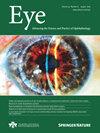The potential role of retinal slip in National Football League (NFL) officiating and its effect on on-field decision making: mechanisms and countermeasures
IF 2.8
3区 医学
Q1 OPHTHALMOLOGY
引用次数: 0
Abstract
Visual processing involves numerous neuro-ophthalmic pathways that enable humans to perceive and interact with the world. These visual pathways can negatively impact visual perception and decision-making. The Vestibulo-Ocular Reflex (VOR) is a compensatory mechanism that stabilizes gaze on a target during head movement, such as running or turning. However, inadequate VOR stabilization can lead to retinal slip, reducing visual acuity. In the National Football League (NFL), officials require exceptional visual training and performance. NFL officiating utilize rapid visual processing, strategic movements, and precise judgement to make accurate penalty calls in real-time. Retinal slip can adversely affect play calling and penalty assessment by NFL officials. Despite these challenges, NFL officials achieve high precision and accuracy in up to 98.9% of plays. To maintain such high standards, the NFL has implemented a standardized curriculum to mitigate the effects of VOR and retinal slip. This manuscript outlines the basics of VOR function and explores countermeasures to minimize retinal slip in NFL officiating. We believe that these scientific endeavours can improve both penalty assessment accuracy and precision. The use of these general principles might also be potentially applicable to other sports.

视网膜滑动在NFL裁判中的潜在作用及其对场上决策的影响:机制和对策。
视觉处理涉及许多神经-眼通路,使人类能够感知世界并与之互动。这些视觉通路会对视觉感知和决策产生负面影响。前庭眼反射(VOR)是一种补偿机制,在头部运动(如跑步或转身)时稳定凝视目标。然而,不充分的VOR稳定可导致视网膜滑动,降低视力。在美国国家橄榄球联盟(NFL)中,官员们需要特殊的视觉训练和表现。NFL裁判利用快速的视觉处理、战略动作和精确的判断来实时做出准确的判罚。视网膜滑动会对比赛判罚和NFL官员的处罚评估产生不利影响。尽管存在这些挑战,NFL官员在高达98.9%的比赛中实现了高精度和准确性。为了保持如此高的标准,NFL已经实施了标准化的课程,以减轻VOR和视网膜滑动的影响。本文概述了VOR功能的基础知识,并探讨了在NFL裁判中尽量减少视网膜滑动的对策。我们相信这些科学的努力可以提高处罚评估的准确性和精确性。这些一般原则的使用可能也适用于其他运动。
本文章由计算机程序翻译,如有差异,请以英文原文为准。
求助全文
约1分钟内获得全文
求助全文
来源期刊

Eye
医学-眼科学
CiteScore
6.40
自引率
5.10%
发文量
481
审稿时长
3-6 weeks
期刊介绍:
Eye seeks to provide the international practising ophthalmologist with high quality articles, of academic rigour, on the latest global clinical and laboratory based research. Its core aim is to advance the science and practice of ophthalmology with the latest clinical- and scientific-based research. Whilst principally aimed at the practising clinician, the journal contains material of interest to a wider readership including optometrists, orthoptists, other health care professionals and research workers in all aspects of the field of visual science worldwide. Eye is the official journal of The Royal College of Ophthalmologists.
Eye encourages the submission of original articles covering all aspects of ophthalmology including: external eye disease; oculo-plastic surgery; orbital and lacrimal disease; ocular surface and corneal disorders; paediatric ophthalmology and strabismus; glaucoma; medical and surgical retina; neuro-ophthalmology; cataract and refractive surgery; ocular oncology; ophthalmic pathology; ophthalmic genetics.
 求助内容:
求助内容: 应助结果提醒方式:
应助结果提醒方式:


